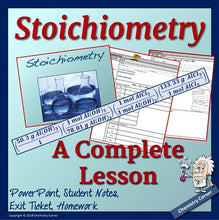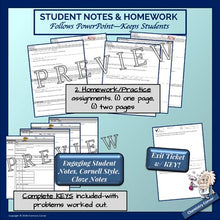This lesson will introduce students to stoichiometry. The lesson is based on a very successful strategy that I have been using for years. My students become stoichiometry masters after this lesson, and have told me tells of teaching their friends, college classmates, and youth groups stoichiometry.
This is a complete lesson with PowerPoint, student notes, exit ticket, two homework assignments, a quiz, and two graphic organizers. This resource also contains teacher notes that are full of great hints, and tips for addressing this stoichiometry teaching strategy, and slide-by-slide background notes for the teacher.
The lesson addresses conversions involving mass, number of particles, and liters @ STP.
Objectives:
-
Define stoichiometry.
-
Describe the function of the mole to mole conversion factor.
-
Write mole to mole conversion factors for a chemical equation.
-
Calculate the amount of product or reactant in moles, mass, or liters from an amount of a different product or reactant in moles, mass, or liters.
Prior Knowledge for Students: Students should be comfortable with dimensional analysis, nomenclature, molar mass, writing chemical equations for reactions, and mole conversions prior to this lesson.
Teacher Prep Time: Just print and go!
Lesson Duration: One – Two class periods plus practice.
Included in This Product:
-
Editable, Animated PowerPoint (27 slides)
-
Cornell Style Student Notes that follow the PowerPoint (Cloze Notes)
-
Student Example of Completed Notes
-
(2) Graphic Organizers: The Mole, and Stoichiometry Conversions
-
(2) Homework/Practice assignments w/KEY—all problems completely worked out
-
Quiz w/KEY
-
Check for Understanding (exit ticket) w/KEY
-
Teacher Notes pages (3 pages) Slide-by-slide background notes for the PowerPoint.
Note on the PowerPoint: The PowerPoint included in this product is editable. It is also animated, which means that it may appear busy or overlapping in the slide edit mode, but will be awesome in the slide show mode! Please don’t edit the PowerPoint until you have seen it in the slide show mode!
This lesson is appropriate for grades 9-12 chemistry.
This will be a lesson you will want to use year after year!
Chemistry Corner
**************************************************************************************
Check out these other products that you may be interested in:
High School Chemistry Year Curriculum
Chemistry Doodle Notes for the Year
Chemistry: The Mole
*************************************************************************************
Chemistry Corner’s PowerPoints are perfect for the flipped classroom. However, please read the Copyright Terms below before using it as such. Thanks!
LICENSING TERMS: By purchasing this product, you own a license for one teacher only for personal use in your classroom. Licenses are non-transferable, meaning they cannot be passed from one teacher to another. No part of this resource is to be shared with colleagues or used by an entire grade level, school, or district without purchasing the proper number of licenses. I you are a coach, principal or district interested in transferable licenses to accommodate yearly staff changes, please contact beth@chemistrycorner.com.
COPYRIGHT TERMS: © Chemistry Corner. Please note – all material included in this resource belongs to Chemistry Corner. By purchasing, you have a license to use the material, but you do not own the material. This resource, or any portion of this resource, may not be uploaded to the internet in any form, including classroom/personal websites or network drives, unless the site is password protected and can only be accessed by students—no other teachers or anyone else on the internet.








